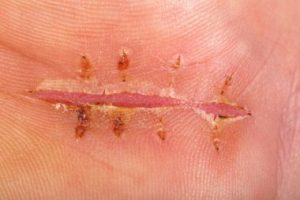
How Long After Stitches Removed Can I Exercise (6 Useful Guidelines)
How long after stitches removed can I exercise? It’s typically recommended to wait at least a week before resuming strenuous activities to allow proper wound healing. Embarking on the journey of post-stitch liberation, you’re likely yearning to break free from the constraints of caution and dive back into your fitness routine with unbridled enthusiasm.
Yet, as you eagerly contemplate the moment you can lace up your sneakers or hit the gym, a pertinent question arises: How long must you wait before unleashing your inner athlete once again? Like a finely woven tapestry of convalescence and anticipation, the period after stitch removal delicately balances the need for patience with the eagerness to resume physical activity. So, lace up your curiosity and unravel the threads of recovery and unveil the optimal timing for you to reclaim the joy of movement post-stitches.

How Long After Stitches Removed Can I Exercise
You can generally start exercising again 1-2 weeks after having stitches removed, but it’s important to consult your healthcare provider for personalized advice.
Healing Process
Your body needs time to heal properly after stitches are removed. Exercise too soon can put stress on the healing tissue and increase the risk of complications such as reopening the wound or developing an infection.
Type of Stitches
The type of stitches used and the size of the wound will influence how long it takes to heal. Dissolvable stitches may require less time before resuming exercise compared to non-dissolvable ones.
Location of the Wound
Wounds located in high-mobility areas like joints or areas prone to sweating may require more time to heal before exercising. It’s essential to be mindful of how movement could impact the healing process.
Factors Affecting Exercise After Stitches Removal
Type of Injury
After the removal of stitches, several factors influence an individual’s ability to resume exercise, particularly dependent on the type of injury sustained. Injuries vary widely, ranging from minor cuts to significant surgical procedures, each requiring different levels of care and rehabilitation. Factors such as the location and severity of the injury, as well as the extent of tissue damage, dictate the timeline and intensity of post-stitch removal exercise.
For instance, individuals recovering from minor cuts may be able to resume light exercise sooner than those who underwent major surgeries. Additionally, adherence to healthcare provider recommendations, including proper wound care and rehabilitation exercises, plays a crucial role in determining when and how exercise can safely resume. It’s essential to prioritize gradual progression, listening to one’s body, and seeking professional guidance to ensure a smooth and effective transition back to physical activity post-stitch removal.
Location of Stitches
After the removal of stitches, the location of the wound plays a crucial role in determining the extent and type of exercise one can undertake. For instance, if the stitches were in an area prone to stretching or movement, such as joints or muscles, individuals might need to be cautious with exercises that strain these regions. Engaging in high-impact activities or those that involve repetitive motions could potentially reopen the wound or cause discomfort. Therefore, it’s advisable to consult with a healthcare professional to determine the appropriate exercise regimen post-stitch removal, ensuring it promotes healing without risking complications.

Number of Stitches
After the removal of stitches, several factors come into play when considering resuming exercise. The foremost factor is the number of stitches required for the wound closure. This number dictates the level of wound healing and tissue repair needed, directly impacting the intensity and type of physical activity advisable.
A higher number of stitches typically indicates a larger or deeper wound, necessitating more caution and potentially a longer recovery period before engaging in strenuous exercise. It’s crucial to follow medical advice regarding post-stitch care and activity levels to avoid complications like reopening the wound or excessive strain on healing tissues. Gradually reintroducing exercise, starting with low-impact activities and monitoring for any signs of discomfort or complications, is essential for a safe and successful recovery.
Healing Progress
After the removal of stitches, several factors come into play that can influence the progress of healing and the ability to resume exercise. Firstly, the extent and location of the wound play a significant role; wounds in areas subject to constant movement or pressure may require more time to heal fully. Compliance with post-operative care instructions, including wound care and activity restrictions, is crucial. Ignoring these instructions or prematurely engaging in strenuous exercise can increase the risk of reopening the wound or developing complications. Furthermore, maintaining a balanced diet rich in nutrients supports the body’s healing process.

Individual Health and Fitness Level
After the removal of stitches, engaging in exercise requires careful consideration, particularly regarding individual health and fitness levels. Factors such as pre-existing health conditions, overall fitness level, and the nature of the procedure can significantly impact one’s ability to resume physical activity. Individuals with underlying health issues may need to consult with healthcare professionals to determine appropriate exercise regimens post-stitch removal.
Moreover, the level of fitness prior to the procedure plays a crucial role in determining the intensity and type of exercise that can be safely resumed. It’s essential to start gradually and listen to one’s body to avoid complications and ensure a smooth recovery process. Adjustments in exercise intensity and type may be necessary to accommodate the healing process and prevent any strain or injury.
General Guidelines for Exercise After Stitches Removal
Consultation with Healthcare Provider
After the removal of stitches, it’s crucial to proceed with caution when resuming exercise to ensure proper healing and prevent any complications. General guidelines for exercise after stitches removal typically begin with consulting your healthcare provider. Their insight into your specific condition and healing progress is invaluable in determining the appropriate timing and intensity of exercise.
They can provide personalized recommendations tailored to your situation, taking into account factors such as the location of the stitches, the extent of the wound, and your overall health. This consultation ensures that you’re cleared to engage in physical activity safely, minimizing the risk of reopening the wound or causing undue strain. It’s essential to adhere to their advice to promote optimal recovery and return to your regular exercise routine gradually and safely.
Gradual Return to Normal Activity
After having stitches removed, it’s crucial to approach returning to exercise with care to avoid any complications. General guidelines for exercise post-stitches removal emphasize a gradual return to normal activity. Start by engaging in light activities such as walking or gentle stretching to assess your body’s readiness and gauge any discomfort or limitations. Listen to your body closely and refrain from pushing yourself too hard too soon. As you progress, gradually reintroduce more strenuous exercises, but continue to prioritize caution and avoid activities that may put excessive strain on the healing area. Remember, patience and gradual progression are key to ensuring a smooth recovery and preventing any setbacks.
Monitoring Pain and Discomfort
After the removal of stitches, it’s crucial to adhere to general guidelines to ensure a smooth recovery process. One of the primary considerations is monitoring pain and discomfort. While some level of discomfort is normal after the procedure, excessive pain may signal complications such as infection or improper healing.
It’s essential to communicate any unusual sensations to your healthcare provider promptly. Additionally, adhering to prescribed pain management strategies, such as taking prescribed medications or using ice packs as recommended, can help alleviate discomfort effectively. Consistently monitoring pain levels enables timely intervention, promoting a faster and safer recovery.
Recognizing Signs of Overexertion
General guidelines include gradually increasing activity levels, starting with light exercises such as walking or gentle stretching. Avoid strenuous activities that could strain the area where the stitches were removed, and listen to your body’s signals to avoid overexertion. It’s important to keep the area clean and dry, and if there’s any discomfort or unusual swelling during or after exercise, it’s best to stop immediately and consult a healthcare professional.
Recognizing signs of overexertion such as excessive fatigue, dizziness, or increased pain is essential. If any of these symptoms occur, it’s crucial to rest and allow the body to recover fully before resuming exercise. Overall, prioritizing gentle movements and gradually increasing intensity can support a smooth recovery process after stitches removal.
Timeframe for Resuming Exercise After Stitches Removal
Immediate Post-Removal Period
After the removal of stitches, it’s crucial to adhere to a suitable timeframe before resuming exercise. During the immediate post-removal period, prioritizing rest is paramount. This allows the body to heal properly and reduces the risk of reopening the wound. Light activities and movements can gradually be introduced, focusing on gentle stretches or short walks to promote blood circulation and aid in the healing process.
Short-Term Recovery Phase (1-2 Weeks)
Following the removal of stitches, the short-term recovery phase, typically spanning 1-2 weeks, calls for caution and gradual reintegration into exercise routines. Intense exercise should be avoided during this time to prevent reopening of the wound and facilitate proper healing. Instead, emphasis should be placed on gentle movements that promote blood circulation and flexibility without placing undue strain on the affected area. Activities such as walking and engaging in low-impact exercises can be beneficial, aiding in maintaining overall fitness levels while allowing the body to heal effectively. It’s essential to listen to the body’s signals and consult with a healthcare professional regarding the appropriate timeframe for resuming more intense exercise regimens.
Medium-Term Recovery Phase (2-4 Weeks)
Following the removal of stitches, the medium-term recovery phase typically spans from 2 to 4 weeks, during which individuals must proceed with caution as they reintegrate exercise into their routine. It’s crucial to prioritize gradual increases in intensity to avoid straining the healing area. Depending on the location of the stitches and the nature of the wound, resistance training may be introduced cautiously to rebuild strength. Throughout this phase, close monitoring of the healing progress is essential, with any signs of discomfort or complications warranting immediate medical attention to ensure a safe and effective return to physical activity.
Long-Term Recovery Phase (4+ Weeks)
After the removal of stitches, the timeframe for resuming exercise largely depends on the extent of the injury and the advice of a healthcare professional. During the long-term recovery phase, typically lasting four weeks or more, it’s crucial to prioritize gradual reintroduction to physical activity. Returning to a full exercise routine should be approached cautiously, with a focus on listening to the body’s signals. Incorporating stretching and flexibility exercises becomes essential during this phase to enhance mobility and prevent stiffness. By paying attention to one’s body and gradually increasing activity levels, individuals can ensure a safe and effective return to their pre-injury exercise regimen.
Types of Exercises to Consider After Stitches Removal
Cardiovascular Exercises
After the removal of stitches, it’s crucial to ease back into physical activity while ensuring the wound heals properly. Cardiovascular exercises offer a great starting point, promoting overall health and aiding in recovery. Walking emerges as a gentle yet effective option, gradually increasing endurance and mobility. Swimming becomes viable once the wound has completely healed and is waterproof, offering a low-impact, full-body workout. Additionally, stationary cycling provides a controlled environment for cardiovascular exercise, minimizing strain on the healing area while improving cardiovascular fitness. These exercises not only aid in physical recovery but also contribute to overall well-being, gradually restoring strength and stamina.
Strength Training
After the removal of stitches, it’s crucial to ease back into physical activity gradually, ensuring the healing process is not disrupted. Several types of exercises are suitable for this stage. Strength training, utilizing resistance bands or machines with light weights, helps rebuild muscle strength without straining the healing incision site. Light weightlifting, focusing on low weights and high repetitions, aids in maintaining muscle tone and enhancing overall strength.
Additionally, bodyweight exercises such as squats, lunges, and push-ups provide a safe way to engage multiple muscle groups while gradually increasing intensity as tolerated. These exercises not only promote physical recovery but also contribute to overall well-being post-surgery. As always, it’s essential to consult with a healthcare professional or physical therapist before starting any new exercise regimen after stitches removal to ensure it aligns with individual recovery needs.

Flexibility and Stretching
Flexibility and stretching exercises are excellent choices during this phase, helping to regain range of motion and prevent stiffness. Gentle yoga can also be beneficial, offering a blend of stretching, strengthening, and relaxation techniques that promote overall well-being while being mindful of not putting undue pressure on the healed areas.
Similarly, Pilates focuses on core strength, flexibility, and balance, offering a low-impact workout that can aid in recovery without risking injury to recently healed wounds. These exercises not only contribute to physical rehabilitation but also foster a sense of rejuvenation and mental calmness during the healing process. As always, it’s crucial to consult with a healthcare professional before starting any exercise regimen post-stitches removal to ensure safety and suitability for individual circumstances.
Sports-Specific Training (if applicable)
After the removal of stitches, it’s crucial to gradually reintroduce physical activity to avoid complications. One approach is sports-specific training tailored to the individual’s interests and previous level of activity. This ensures a smooth transition back into sports while minimizing the risk of re-injury. Additionally, a gradual return to sport activities is essential, starting with low-impact exercises and gradually increasing intensity and duration as the body heals.
Modifications to reduce the risk of injury should also be considered, such as incorporating strength and flexibility exercises, proper warm-up and cool-down routines, and using protective gear when necessary. By prioritizing these types of exercises, individuals can safely resume their active lifestyles post-stitch removal.
Warning Signs and Complications
Excessive Pain or Discomfort
Warning signs and complications often accompany excessive pain or discomfort, serving as critical indicators of underlying issues that warrant attention. Persistent or escalating pain beyond the expected recovery period following an injury or medical procedure can signify complications such as infection, nerve damage, or internal bleeding.
Additionally, pain that is unresponsive to prescribed medications or worsens with movement may indicate a need for urgent medical evaluation. Ignoring such warning signs can lead to further complications, including impaired mobility, chronic pain, or even life-threatening conditions. Therefore, it is imperative to promptly address any excessive pain or discomfort by seeking medical advice to ensure appropriate management and prevent potential complications.
Increased Swelling or Redness
Warning signs and complications can arise, notably when there’s an increase in swelling or redness. These symptoms can often indicate a deeper issue, such as infection or inflammation, necessitating prompt medical attention. Swelling beyond the usual extent or redness that becomes more pronounced may suggest that the body’s immune response is escalating or that an infection is spreading.
Ignoring such signs can lead to further complications, including the spread of infection to surrounding tissues or even systemic infection, posing significant health risks. Therefore, vigilance and prompt action are crucial when these warning signs manifest, ensuring appropriate management and minimizing the potential for complications.
Bleeding or Drainage from the Wound
Bleeding or drainage from a wound, can indicate potential issues that require immediate attention. Any unexpected bleeding or excessive drainage from a wound should be promptly evaluated by a healthcare professional. These symptoms might suggest infection, inadequate wound healing, or other underlying problems that need to be addressed to prevent further complications.
Monitoring the color, consistency, and amount of drainage can provide valuable insights into the wound’s healing progress and help determine the appropriate course of action for optimal recovery. Early recognition and management of warning signs can significantly reduce the risk of complications and promote successful healing.
Development of Infection
Warning signs and complications can arise during the development of an infection, signaling a potential escalation in severity. Symptoms such as fever, chills, increased pain, swelling, redness, or warmth at the site of infection are common indicators that should not be ignored.
Additionally, symptoms like nausea, vomiting, fatigue, and confusion may suggest a systemic response, indicating the infection’s spread. If left untreated, infections can lead to severe complications such as sepsis, where the body’s response to infection causes widespread inflammation and organ damage, or even septic shock, a life-threatening condition. Prompt recognition and treatment of warning signs are crucial to prevent such complications and facilitate a swift recovery.
Impaired Range of Motion
Warning signs and complications related to impaired range of motion can manifest in various ways, indicating potential underlying issues. Individuals may experience stiffness, tightness, or discomfort in their joints, limiting their ability to move freely. Persistent pain or inflammation around the affected area could signify worsening conditions such as arthritis or tendonitis.
Furthermore, complications may arise if impaired range of motion is left untreated, including muscle weakness, joint instability, and even loss of function. It’s crucial to heed these warning signs and seek medical attention promptly to prevent further deterioration and ensure proper management of the underlying condition. Early intervention through physical therapy, exercises, or other medical interventions can often alleviate symptoms and improve mobility, minimizing the risk of complications.
Frequently Asked Questions (FAQ) About How Long After Stitches Removed Can I Exercise
Q1. How long should I wait before exercising after having stitches removed?
A. Typically, it’s recommended to wait at least 1-2 weeks after stitches are removed before engaging in strenuous physical activity. However, this can vary depending on the type of wound and your individual healing process.
Q2. What types of exercises are safe after stitches removal?
A. Light, low-impact activities like walking or gentle stretching are usually safe soon after stitches removal. Consult with your healthcare provider for personalized recommendations based on your specific situation.
Q3. Can I resume my regular exercise routine immediately after stitches are removed?
A. It’s essential to gradually reintroduce physical activity and avoid overexertion. Start with light exercises and gradually increase intensity as your body heals.
Q4. What signs indicate that I’m not ready to exercise after stitches removal?
A. If you experience increased pain, swelling, redness, or any unusual discharge from the wound site, it’s important to refrain from exercising and consult your healthcare provider immediately.
Q5. Are there specific precautions I should take when exercising after stitches removal?
A. Yes, it’s crucial to protect the wound area from irritation or injury during exercise. Consider using bandages or dressings if the wound is still healing and avoid activities that put excessive strain on the affected area.
Q6. Can I swim or take baths after having stitches removed?
A. It’s generally recommended to avoid swimming or soaking in water until the wound is fully healed and any scabs have fallen off. Water exposure can increase the risk of infection or cause the wound to reopen.
Q7. How can I ensure a smooth recovery process while resuming exercise after stitches removal?
A. Prioritize proper wound care, including keeping the area clean and dry, following your healthcare provider’s instructions for any prescribed medications or dressings, and listening to your body’s signals to avoid overdoing it.
Q8. Is it normal to experience discomfort or tightness when exercising after stitches removal?
A. Some mild discomfort or tightness around the wound site can be normal as your body adjusts to increased activity. However, if you experience severe pain or any unusual symptoms, it’s essential to seek medical attention promptly.
Q9. Should I avoid specific types of exercises altogether after having stitches removed?
A. While most low-impact activities are generally safe, it’s best to avoid high-impact exercises or activities that put excessive strain on the wound area until it’s fully healed to prevent complications or reopening of the wound.
Q10. How can I tell if I’m pushing myself too hard while exercising after stitches removal?
A. Pay attention to your body’s signals. If you feel unusually fatigued, experience increased pain, or notice any signs of distress, it’s crucial to stop exercising and give your body adequate rest to prevent further injury.
Conclusion
In conclusion, while physical activity is essential for maintaining overall health and well-being, it is crucial to prioritize proper wound healing after stitches are removed. The duration before resuming exercise varies depending on factors such as the type and location of the wound, as well as individual healing rates. Consulting with a healthcare professional is paramount to ensure a safe and timely return to physical activity.
Typically, it is recommended to wait at least a few days to a few weeks after stitches are removed before engaging in strenuous exercise to minimize the risk of reopening the wound and promoting optimal healing. Listening to your body and gradually reintroducing activity is key to a successful recovery process, ultimately allowing you to return to your fitness routine with confidence and reduced risk of complications.